The Use of Body Part Names in Uzbek Language Metaphors
Keywords:
names of body parts, aesthetic potential, form of thinking, metaphorAbstract
This article is devoted to the actual linguistic problem, the problem of using the names of body parts in the Uzbek language. The paper defines the basic concepts, and also emphasizes the reasons for the metaphorization of the language. In fact, the article explores some metaphorical units of the Uzbek language, which are firmly entrenched in the thinking space.
References
Baranov A.N. Preface of the Editor // Lakoff J., Johnson M. Metaphors, we've been waiting to live. M., 2008. pp. 7 – 21.
Бабаходжаева Н. М. The tеchnоljgies in the Modular in Gredit Training system European Journal of Life Safety and Stability. Ispaniya, 2021 10.12. 102-109 betlarJournal sayti : https://ejlss.es/
Bogdanova M.V. A. Body of man as a mnemoorganic device //Vestnik TSU.– 2012. – No. 358. – pp. 18–20 .
Rakhshtein A.D. Comparative Analysis of German and Russian Phraseology: (For Institutes and Faculties of Foreign Language): Higher School, 1980. 143 p.
Kreidlin G.E., Flying A.B. Conceptualization of body parts on the Russian languages in non-verbal semiotic codes// Russian language .- 2006. - № 12 (2) . - S. 80 -115.
Milashevskaya I. V. Kontetralnaya metafatsiala golova - vmesilishche //Bulletin of Nizhny Novgorod University. . – 2011.-№ 6 -1. – S. 360 -363.
Zhumaev Sh.D.. Karimova G.Kh. On synonymous phraseological nests of russian and Uzbek languages. // Young scientist-2018-No13 S 300-302
Downloads
Published
Issue
Section
License

This work is licensed under a Creative Commons Attribution-NonCommercial 4.0 International License.
User Rights
Under the Creative Commons Attribution-NonCommercial 4.0 International (CC-BY-NC), the author (s) and users are free to share (copy, distribute and transmit the contribution).
Rights of Authors
Authors retain the following rights:
1. Copyright and other proprietary rights relating to the article, such as patent rights,
2. the right to use the substance of the article in future works, including lectures and books,
3. the right to reproduce the article for own purposes, provided the copies are not offered for sale,
4. the right to self-archive the article.













